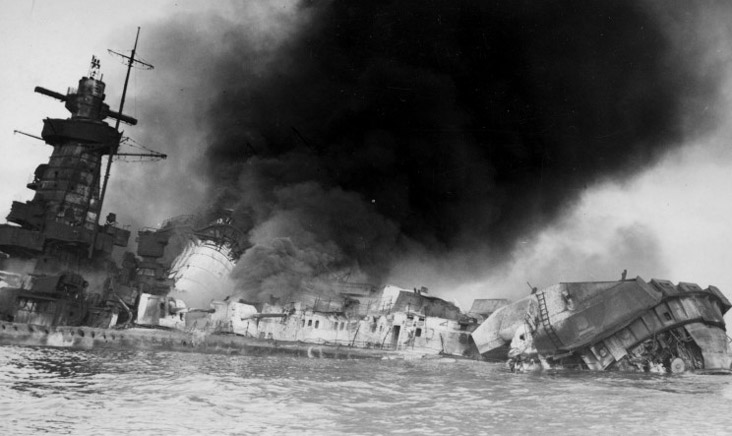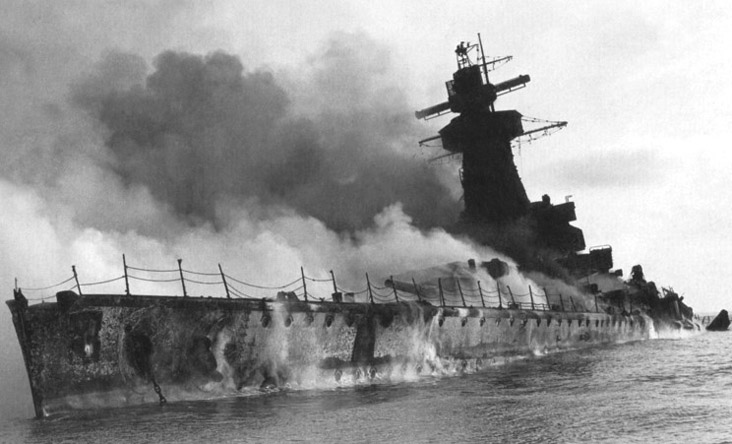'Graf Spee' Pays the Full Price of Defeat
The War Illustrated, Volume 1, No. 19, Page 591, January 12, 1940.
All Montevideo's quays, piers, breakwaters, and adjacent coastline were densely crowded with people breathlessly watching the German corsair. The crowds stood silent as the great ship passed to sea. Suddenly she turned, not as they expected to seaward where the ships of Britain watched, but westward towards the setting sun... Her speed dropped to dead slow, then she stuck her nose into a mudbank and stopped and her anchor was dropped.
The hour was 8 p.m. and the sun was dipping below the river's western rim. Suddenly there was a flash of flame and a double explosion which shook the air, and the centre of the ship was blotted from view by a cloud of dense black smoke. The concussion had not died away before a blinding burst of flame shot from the after part of the ship high above her masthead, and a thunderous roar deafened the ears of the watching crowds. The whole ship seemed to life and crumple as though inferno itself had burst forth from her vitals...
Out to seaward could be seen the flicker of a Morse lamp and the distant flash of a searchlight from a British cruiser going about her business.
From a message to the "Daily Telegraph" by a Special Correspondent in Montevideo, Captain Henry Daniel, D.S.C.
 Aflame from bow to stern, the "Graf Spee" is slowly sinking into the waters of the Plate. This dramatic photograph was taken by Captain Henry Daniel. The white funnel has collapsed in dense clouds of smoke. "Sheets of flame spread over the tranquil sea", wrote Captain Daniel, "as the oil from the bunkers of the riven ship came to the surface and caught fire. Dense clouds of smoke rose in the air, and soon the wreck was a blazing inferno from stem to stern. It was the end of the tragedy." Photo, Courtesy of the "Daily Telegraph".
Aflame from bow to stern, the "Graf Spee" is slowly sinking into the waters of the Plate. This dramatic photograph was taken by Captain Henry Daniel. The white funnel has collapsed in dense clouds of smoke. "Sheets of flame spread over the tranquil sea", wrote Captain Daniel, "as the oil from the bunkers of the riven ship came to the surface and caught fire. Dense clouds of smoke rose in the air, and soon the wreck was a blazing inferno from stem to stern. It was the end of the tragedy." Photo, Courtesy of the "Daily Telegraph".
Previous and next article from The Battle of the River Plate
Last Scenes of All in the Battle of the River Plate
A great "naval occasion" was the dramatic engagement between the "Admiral Graf Spee" and the British cruisers on December 13, in which the British ships, thought outclassed, showed a seamanship and fi
I Was There! - Our Ships were Sunk by the 'Graf Spee'
Only after the sinking of the "Graf Spee" was it clear that it was she, and not the "Admiral Scheer", which sank the "Clement" (see page 382) and the "Africa Shell". A later story of the sinking of th
Index
Previous article
Next article
Germany Lost That War: How Can She Win This?
In 1918 Imperial Germany reached the zenith of her conquests, and in a few brief months crashed into stupendous ruin and defeat. In 1939 Nazi Germany set out on the same trail, yet (as this article an




